How to Install Latest Deluge BitTorrent Client on Ubuntu 16.04/14.04
Deluge is a free, open-source and lightweight BitTorrent client, available for Linux, FreeBSD, Mac OS X and Windows. It has a rich collection of plugins that you can install to extend its functionality. The latest stable version, 1.3.13, was released on July 20, 2016. Deluge BitTorrent 1.3.13 features an extremely large set of bug fixes.
Install Latest Deluge on Ubuntu 16.04/14.04 Desktop from PPA
The Ubuntu software repository includes Deluge 1.3.12. To ensure that you get the most recent version, you need to install it from official Deluge PPA. Fire up a terminal window (CTRL+ALT+T), then run the following 2 lines of comands one at a time.
sudo add-apt-repository ppa:deluge-team/ppa sudo apt update && sudo apt install deluge
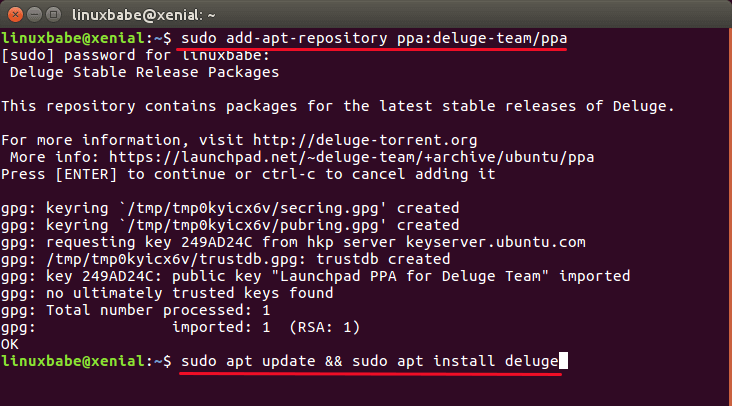
This PPA also works on other Linux distributions that are based on Ubuntu 16.04/14.04 such as Linux Mint and Elementary OS. If you already have deluge installed, then the above commands will update your deluge to the latest version. Don’t worry, your existing torrents will be fine.
Once installed, you can start it from Unity Dash or application menu.

Deluge 1.3.13 user interface
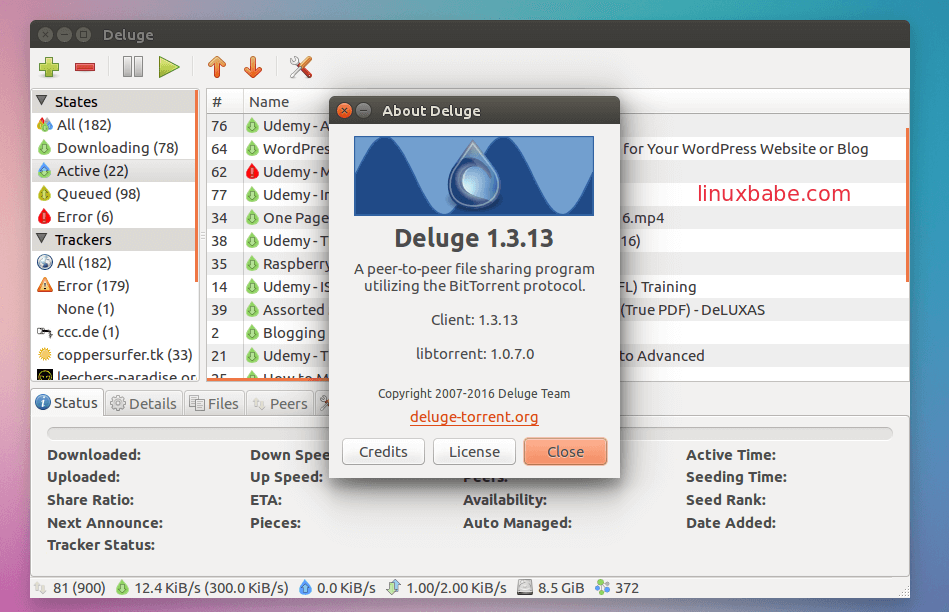
You may want to use a VPN to hide your IP address when downloading torrents.
Install Deluge BitTorrent on Ubuntu 16.04 Server
You can install Deluge BitTorrent daemon on a server and manage the program via a Web browser. Using a server to download torrrent is very fast. Today’s server typically has 100Mbit download and upload speed.
Use the following command to install Deluge Web UI and the Deluge daemon on Ubuntu 16.04 server
sudo add-apt-repository ppa:deluge-team/ppa sudo apt-get update sudo apt-get install deluge-webui deluged
Then create the deluge user and group so that deluge can run as a separate user. This will increase your server’s security.
sudo adduser --system --gecos "Deluge Service" --disabled-password --group --home /var/lib/deluge deluge
The --disabled-password flag disables login for the deluge user. You may want to add your user account to the deluge group with the following command so that the user account has access to the files downloaded by Deluge BitTorrent.
sudo gpasswd -a your-user-name deluge
Once that’s done, create a systemd service file for deluge with your favourite text editor such as nano.
sudo nano /etc/systemd/system/deluged.service
Copy and paste the following lines into the file.
[Unit] Description=Deluge Bittorrent Client Daemon After=network-online.target [Service] Type=simple User=deluge Group=deluge UMask=007 ExecStart=/usr/bin/deluged -d Restart=on-failure # Configures the time to wait before service is stopped forcefully. TimeoutStopSec=300 [Install] WantedBy=multi-user.target
In nano text editor, press CTRL+O to save the file, then CTRL+X to exit. Now start deluge deamon with the following command. Since we want Deluge to run as the deluge user, there’s no need to add sudo to the command, but you will be asked to enter your password.
systemctl start deluged
You may also want to enable auto start when Ubuntu 16.04 is booted up.
systemctl enable deluged
Check Deluge status:
systemctl status deluged

You can see that deluged is running and enabled.
Accessing Deluge WebUI
To be able to access the deluge WebUI, we also need to create a systemd service file for deluge web.
sudo nano /etc/systemd/system/deluge-web.service
Copy and paste the following texts into the file.
[Unit] Description=Deluge Bittorrent Client Web Interface After=network-online.target [Service] Type=simple User=deluge Group=deluge UMask=027 ExecStart=/usr/bin/deluge-web Restart=on-failure [Install] WantedBy=multi-user.target
Save and close the file. Then start and enable deluge-web, check its status. Again, there’ no need to add sudo to the commands.
systemctl start deluge-web systemctl enable deluge-web systemctl status deluge-web
The deluge-web service will listen on TCP 8112 port. Now in your Web browser address bar, type
your-server-ip:8112
You will be asked to enter a password, which by default is deluge, to access the Web UI. It’s recommended to change the default password. (Your firewall might be preventing access to port 8112, so check your firewall setting if you can’t access the web UI.)
After you choose to change password, the connection manager window will pop up asking you to connect to Deluge daemon which is listening on 127.0.0.1:58846. Select the connection and click Connect button.
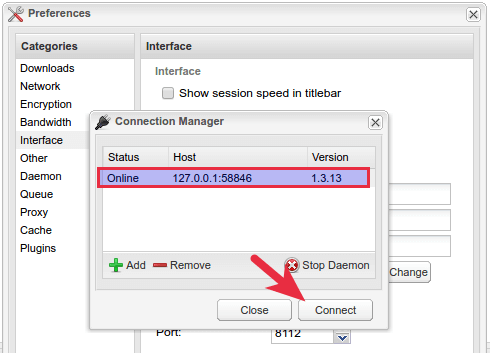
Then you will be able to change the WebUI password. Note that you need to click the Change button to apply this change.
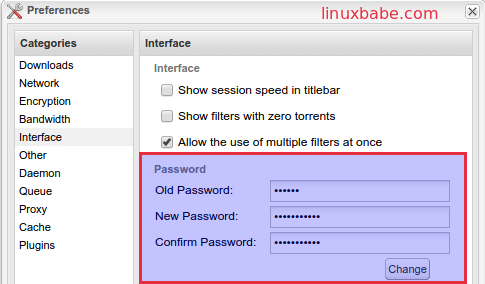
And now you can start using Deluge BitTorrent on your Ubuntu 16.04 server.
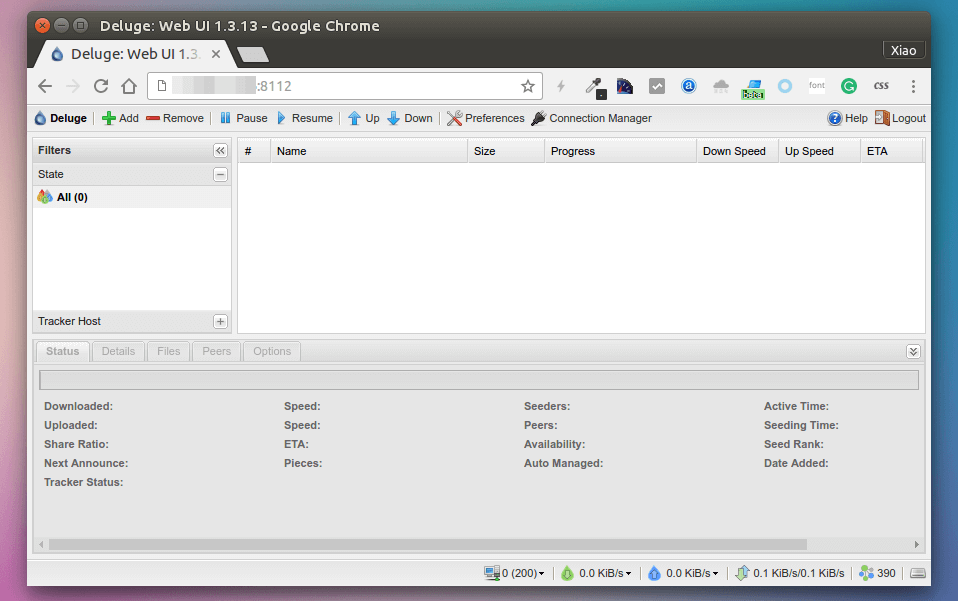
To add new torrents, click the add button on the upper left corner.
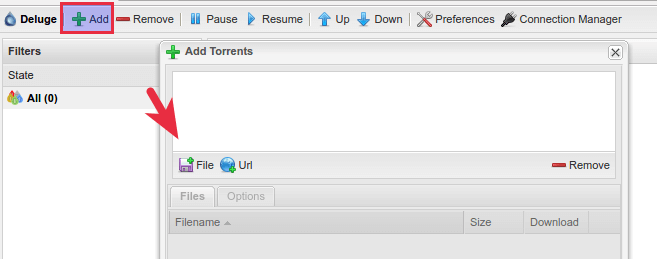
You can add a torrent file from your local computer or add magnet link. By default, files are downloaded to /var/lib/deluge/Downloads/ directory.
Set Up Nginx Reverse Proxy for Deluge WebUI
A reverse proxy is a proxy for another server, in this case the Deluge WebUI. First install Nginx on Ubuntu 16.04.
sudo apt install nginx
Start Nginx
sudo systemctl start nginx
Then create a Nginx server block file for Deluge WebUI.
sudo nano /etc/nginx/conf.d/deluge-webui.conf
Copy and paste the following texts into the file. Replace the red-colored text with your own domain name. You should also set the A record for your domain name.
server {
listen 80;
server_name torrent.yourdomain.com;
access_log /var/log/nginx/torrent.yourdomain.com.log;
location / {
proxy_pass http://127.0.0.1:8112;
}
}
Save and close the file. Then test Nginx configuration.
sudo nginx -t
If the test is successful, reload Nginx
sudo systemctl reload nginx
Now you can access Deluge WebUI via your domain name (torrent.yourdomain.com).
Enable HTTPS
To secure the Web UI, you can install a free Let’s Encrypt certificate. First you need to install the Let’s Encrypt client (certbot).
sudo apt install software-properties-common sudo add-apt-repository ppa:certbot/certbot sudo apt update sudo apt install certbot python3-certbot-nginx
Python3-certbot-nginx is the Certbot Nginx plugin. After they are installed, run the following command to automatically obtain and install Let’s Encrypt certificate.
sudo certbot --nginx --redirect --agree-tos --hsts --staple-ocsp --email your-email-address -d torrent.yourdomain.com
Once that’s done, refresh deluge Web UI. It will be automatically redirected to HTTPS connection.
Do you like Deluge? What other BitTorrent client do you recommend? Leave your comments below. As always, if you found this post useful, subscribe to our free newsletter or follow us on Google+, Twitter or like our Facebook page.



Long too path error!
“Long path tool” is very helpful for this problem. You can solve this problem like copy, delete, long path files by using this tool.
I used to have similar problems too, but after using “long path tool” everything was solved.
Following these instructions I can’t connect via the thin client (using client deluge software to connect to deluge server). Do you know how I would enable this?
Maybe your firewall is preventing access to TCP port 8112.
Hello,
My user is not having access to files downloaded by Deluge …
I used the command “sudo gpasswd -a myuser deluge” and even then I do not have access to /var/lib/deluge/Downloads folder.
Thanks in advance.
EDIT:
It would be good to inform those forgetful like me, that after the above command, or better, after finalizing all the configurations, it is necessary to logout and back in again to make the changes take effect. lol
Yes, you need to logout and log back in.
https://uploads.disquscdn.com/images/67722e0726049491cc9cf8fdf72fb9c4ff2c109ee54be46f9471ee1ecd7dc3dc.png
what to do after this
Hi, just accept the EULA.
systemctl start deluged
Failed to start deluged.service: The name org.freedesktop.PolicyKit1 was not provided by any .service files
Huh???
During the accessing deluge webUI the 127.0.0.1:58846 is showing offline so i cann’t connect.
Maybe you need to restart deluged service.
systemctl restart deluged